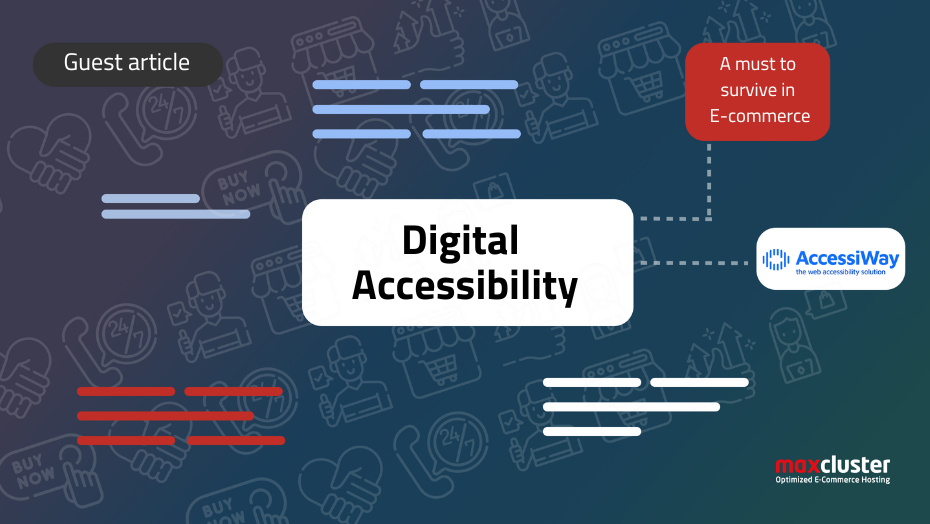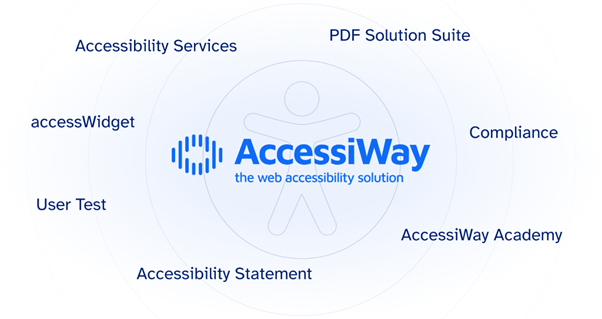Guest article: Digital Accessibility: A Must for Ecommerce Businesses to Survive

E-commerce companies must comply with EU accessibility law by June 2025.
Why is that and what do I need to consider to make my online shop legally compliant? Read on to find out more in the following blog post.
Why accessibility
Why do we even need the EU Accessibility Act, you may ask? The World Health Organization gives the answer: It estimates that approximately 15% of the global population lives with some form of disability. This demographic represents a substantial market segment, with an annual purchasing power of around $1.9 trillion (American Institutes for Research). This is no minor junk, not even for the biggest e-commerce platforms.
Digital Accessibility is the practice of designing websites and apps in a way that individuals with disabilities can perceive, understand, navigate, and interact with them. This involves considering the diverse needs of users, including those with visual, auditory, motor, or cognitive impairments. In essence, it is about providing equal and inclusive access to all digital content.
However, at the current stage of our digitalized economy, digital accessibility is not just a moral obligation. It is also a smart business decision! By prioritizing inclusivity, companies can unlock new opportunities, enhance customer loyalty, and position themselves as leaders in an increasingly competitive market.
Some hard facts about digital accessibility in e-commerce
Inaccessible websites block millions of people from purchasing goods and services every day. There are some really interesting market statistics:
- 82 % of clients with disabilities state they are more likely to make repeat purchases from a company with an accessible website compared to one that is not accessible. (clickawaypound.com)
- 2 out of 3 individuals with visual impairments abandon their shopping carts due to challenges in completing transactions (US Department of Commerce)
- 73% of people with disabilities cannot complete transactions on 25% of the websites (clickawaypound.com)
Search Engine Optimisation (SEO) also improves when accessibility standards are implemented into a digital touchpoint. The company Semrush undertook a large scale study with astonishing results:
- 100% in the sample of more than 800 websites had at least a 12% increase in traffic after implementing accessibility solutions
- 66% of websites had an increase in organic traffic up to 50%.
- 7.3% of websites had an increase in organic traffic of more than 50%
Back to compliance: What is the EU Accessibility Act?
Public sector websites and applications in Europe, along with large businesses of public interest, such as banks, insurance companies, and other essential services, have been required to comply with the European Accessibility Act (EAA). These regulations are designed to ensure that no one, regardless of their abilities, is excluded from accessing essential digital services. This mandate is part of a broader push by the European Union to uphold the principles of inclusion and equal opportunity in the digital space.
The EAA will extend to cover private enterprises by June 2025. Only micro-enterprises with less than 2 million in revenue or less than 12 employees are unaffected. This means that most e-commerce platforms will need to meet so-called Web Content Accessibility Guidelines (WCAG 2.1) accessibility standards to remain compliant. Non-compliance will expose businesses to financial penalties and even potential suspension of their digital business platforms. Failing to provide accessibility could result in public backlash, loss of customers, and diminished brand value, as violations are increasingly made public and retributions are demanded by affected consumers.
Each European country has its own local legislation and consumer rights laws that work in tandem with the EAA. These laws are often tailored to the specific legal frameworks and cultural contexts of each nation, further emphasizing the importance of accessibility in digital platforms. For example, countries like Germany and Italy impose strict obligations on businesses to ensure digital inclusivity and local enforcement bodies actively monitor adherence to these rules. Accessibility is increasingly recognized as a consumer right. We all rely more and more on digital platforms for shopping, communication, and accessing services. Therefore it is only logical that people with disabilities demand equal access to e-commerce platforms.

AccessiWay: the trusted solution for e-commerce
AccessiWay provides digital accessibility as a service. The company utilises a unique combination of experienced experts with best-in-call AI based software solutions. The needs of e-commerce companies vary almost as much as the needs of people. AccessiWay has the unique ability to adapt its service design to all kinds of accessibility demands while ensuring full compliance with international and national standards and regulations. Leading international brands such as Allianz, Intesa Sanpaolo, Dolce & Gabbana, Mercedes trust in AccessiWay.
The challenge in digital accessibility is the variability of frameworks, digital documents (PDF!), apps and websites, design patterns, software management strategies and of course, decision maker structures. In this melange AccessiWay excels in providing the right solution for the right customer.
The solutions

The affordable and impactful entry-level solution is AccessiWay's best-in-class accessWidget. It improves the accessibility of a website with two components working simultaneously: Artificial Intelligence and the Accessibility Interface. While it does not guarantee full compliance with accessibility regulations, it offers a wide range of usability functionalities optimising accessibility and adapting the user experience of websites. In this way, e-commerce platforms can start the first step of their accessibility journey in minutes, implementing a script of 40 lines while trusting in a system with almost 250.000 successful implementations. It is an excellent starting point because its threshold is so low. Immediate benefits are enhanced usability and SEO optimization.
The service packages
Full accessibility by design can be achieved via AccessiWay’s managed service packages, which are tailored to meet the diverse needs of any company. Improving accessibility for an e-commerce website is never a singular task, nor is it a project. Digital accessibility is ongoing control of software quality, commitment and compliance management. While that may sound complicated and like a lot of effort, AccessiWay makes it easy and rewarding.
By opting for an annual package, clients receive a comprehensive, ongoing accessibility strategy. This ensures their digital assets remain accessible, compliant, and up-to-date with evolving regulations and standards. Accessibility is not a static achievement as websites grow, technologies evolve, and user expectations shift, maintaining compliance requires consistent attention and updates. Those annual service packages are designed to address this need seamlessly, offering businesses peace of mind through continuous support and expert guidance: this is what AccessiWay calls Accessibility as a Service, a new way to understand and embed accessibility in the processes of our customers.
Maintenance, audits, tools and training
In e-commerce touchpoints the accessibility journey is comparably simple. Once the initial adjustments are made and the delta to the compliance requirements is erased, the focus shifts to maintenance. Recurring monitoring includes regular audits to identify new barriers that may arise as content and technologies are updated.
The only comparable complex topic for e-commerce companies is accessible PDF documents: a crucial component for many online transactions. Whether dealing with static PDFs, dynamic documents like invoices or forms, or content requiring manual remediation like decks and huge reports, we have the tools and expertise to ensure these files meet accessibility standards.
Finally, training the IT team to implement best practices is essential. User testing with individuals with disabilities can also be integrated into this cycle, as their feedback ensures that e-commerce platforms meet diverse needs effectively, because in the end they are the end users.
Conclusion
By committing to a recurring process of evaluation, updates, and training, e-commerce businesses can not only achieve compliance but also stay ahead of regulatory changes and customer expectations. This proactive approach ensures accessibility remains an integral part of their digital strategy and empowers inclusivity while safeguarding against potential legal and reputational risks.
Beyond compliance and user experience, accessibility has a meaningful societal impact. It ensures that people with disabilities can participate equally in the digital economy. For e-commerce, this means creating opportunities for millions of individuals who may otherwise face barriers to accessing products and services.
By integrating accessibility into their strategy, businesses contribute to a more inclusive digital landscape while gaining a competitive edge. Making the effort to address these issues isn’t just about meeting legal requirements—it’s about recognizing the value of inclusivity for both people and business outcomes.
About the company
Founded in 2021, AccessiWay has driven continuous growth by combining innovative technologies with scalable solutions. In 2024, with over 1,400 clients across Europe, AccessiWay has made a tangible impact on millions of lives daily, breaking down digital barriers and advancing inclusion through technology. Since end of 2024 AccessiWay is part of team.blue.
Published 23.01.2025 | Digital Accessibility in E-Commerce | NM
You have questions, requests, criticism, suggestions or just want to tell us your opinion about our blog? Here you have the opportunity to contact us directly.
Send e-mail